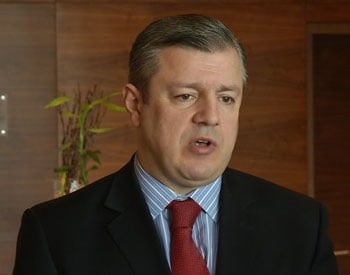published an interview with Minister of Economy and Sustainable Development of Georgia, Giorgi Kvirikashvili. The Minister identified the worsening of the trade balance to be the main reason for the decrease in the volume of USD and the devaluation of GEL. He explained that export from Georgia increased by 8% whilst import increased by 11% which means that more USD has left the country than has entered. The Minister links the decrease in the export growth rate with the ongoing developments in Ukraine and Russia. “The ongoing developments in Ukraine and Russia stimulate export from these countries to Georgia more than from Georgia to these countries,” said Mr Kvirikashvili.
FactChecktook interest in the Minister’s statement and verified it.
RUB (Russian rouble) and UAH (Ukrainian hryvnia) have devaluated significantly. Theoretically, when the currency of a trade partner devaluates, Georgia’s export to the particular partner country becomes expensive and the import therefrom becomes less expensive. Therefore, the devaluations of the national currencies in Ukraine and Russia hinder the increase in Georgian export to these countries and increase import to Georgia. We verified the extent to which the decrease in Georgia’s export growth and the worsening of the country’s trade balance correlate with the ongoing developments in Ukraine and Russia.
The devaluation of GEL began in the second half of November 2014 and reached a maximum of 1.95 (with respect to USD) as of 6 December according to the data of the National Bank of Georgia. In this period, GEL devaluated with respect to USD by GEL 0.20 after which the exchange rate began to stabilise to a certain extent. The devaluation of the GEL exchange rate was mainly due to the worsening of the country’s trade balance. According to the data of GeoStat (National Statistics Office of Georgia), the merchandise export increased by 5% whereas import increased by 11% in the period January to October 2014. The lower growth rate of export, as compared to import, caused Georgia’s trade balance to worsen. In total, within ten months, USD 4.6 million more left the country than entered which ultimately led to the decrease in the volume of USD (FactCheck has previously writtenon this topic).
At this stage, GeoStat’s preliminary datafor November 2014 have already been calculated. According to these data, export has grown only by 0.5% in 11 months whilst Georgia’s trade balance worsened and comprised USD 5.1 billion.
Since August 2014, Georgia’s export has been significantly declining upon a monthly basis. As GeoStat’s November report has not yet been published in full, we analysed the real causes for the decrease in export and the correlation with the Ukrainian and Russian markets based upon ten-month data (only ten-month data had been published by the time the Minister made the statement).
Export to the Russian market increased significantly in 2013-2014. If the Russian market had been sharing only 2% of the gross export previously, nowadays it accounts for nearly 10% of the gross export and represents one of the biggest export countries for Georgia. This year, export to Russia increased by USD 103 million. The 5% growth recorded in the first ten months of 2014 was mainly due to the increase of export to Russia. Excluding export to the Russian market, the ten-month export data of 2014 would have grown only by 0.7% whereas the decline recorded in August-October would have been higher without the Russian market.
It is noteworthy that in parallel with the growth in export to Russia, the ten-month import data decreased by USD 19 million. Therefore, Georgia’s trade balance with Russia improved by USD 122 million.
As for the Ukrainian market, the export in the first ten months of 2014 decreased by nearly USD 19 million whilst import decreased by USD 61 million. However, Georgia’s trade balance with Ukraine improved by USD 42 million.
As we can see, the worsening of the country’s ten-month trade balance does not correlate with Ukraine or with Russia.
Georgia’s largest export destination is Azerbaijan which shares 19.5% of the gross export. According to the ten-month data of 2014, export to Azerbaijan decreased by USD 108 million. The main cause for the decreased export to Azerbaijan is the decrease in the export of the largest merchandise group – motorcars (we have writtenabout this topic previously). In parallel with the export decrease, import from Azerbaijan to Georgia increased by USD 19 million. As a result, Georgia’s trade balance with Azerbaijan worsened by USD 127 million.
According to the ten-month data of 2014, the export to CIS countries, accounting for more than half of Georgia’s exports, decreased by 2% (USD 21 million) and the import increased by USD 0.4% (USD 14 million). In total, the trade balance with CIS countries worsened by USD 35 million.
Conclusion
The devaluation of GEL was due to the decrease in the volume of USD that was in turn caused by the worsening of Georgia’s trade balance. According to GeoStat’s ten-month data of 2014, Georgia’s export growth rate waned and amounted to 5% whereas, according to the 11-month data, export increased insignificantly, only by 0.5%. According to the data of the last months (August-November), the volume of export has been decreasing. In total, Georgia’s trade balance worsened by USD 4.6 billion in ten months.
The Minister explained that the devaluations of the Ukrainian and Russian currencies caused Georgia’s trade balance to worsen. According to the ten-month data, Georgia’s export to Russia increased by USD 103 million whilst import decreased by USD 19 million. Therefore, Georgia’s trade balance with Russia improved by USD 122 million.
As for the Ukrainian market, in the first ten months of 2014, export decreased by nearly USD 19 million whilst import decreased by USD 61 million. Therefore, Georgia’s trade balance with Ukraine has not worsened but, on the contrary, improved by USD 42 million. It is also noteworthy that Georgia’s trade balance with Azerbaijan worsened by USD 127 million whilst with the CIS countries as a whole – by USD 35 million.
FactCheck concludes that Mr Kvirikashvili’s statement is FALSE.





 “The ongoing developments in Ukraine and Russia stimulate export from these countries to Georgia more than from Georgia to these countries.”
“The ongoing developments in Ukraine and Russia stimulate export from these countries to Georgia more than from Georgia to these countries.”












